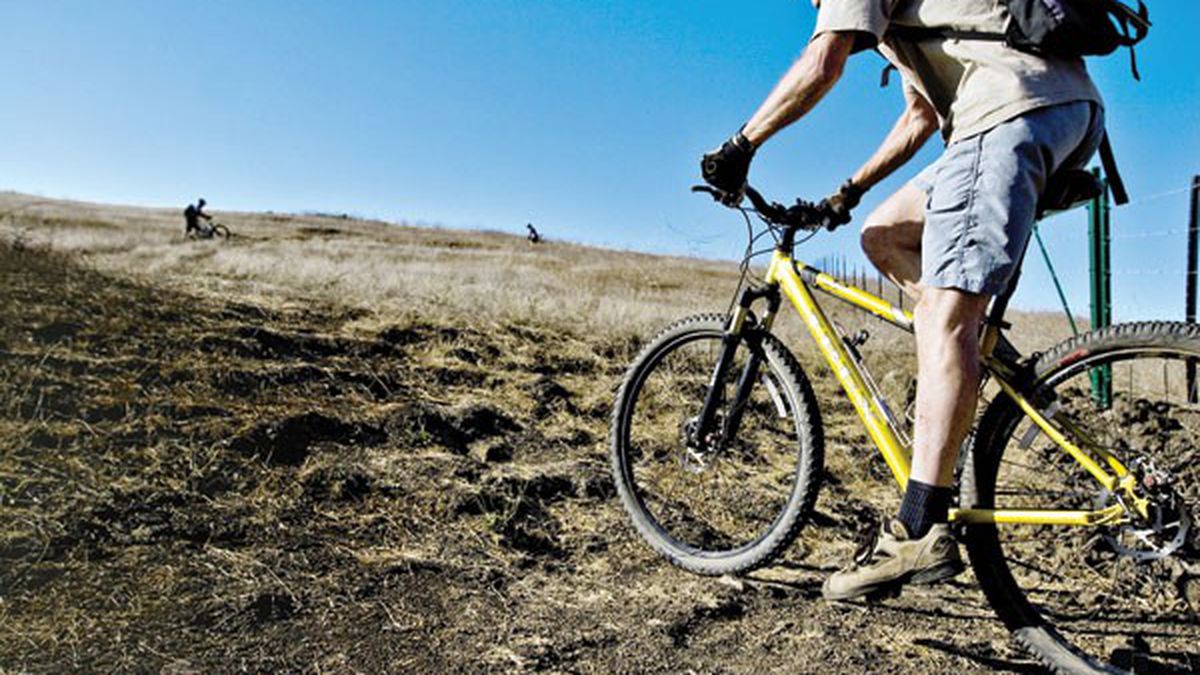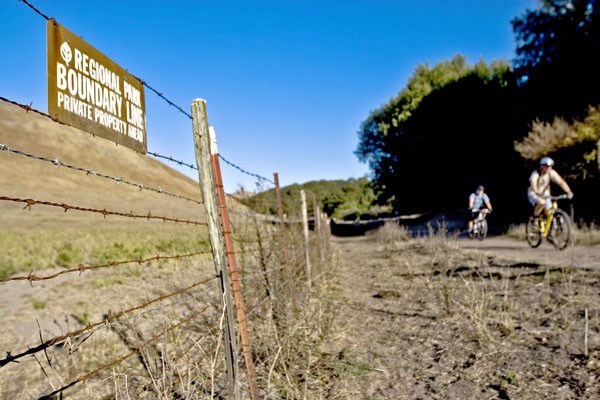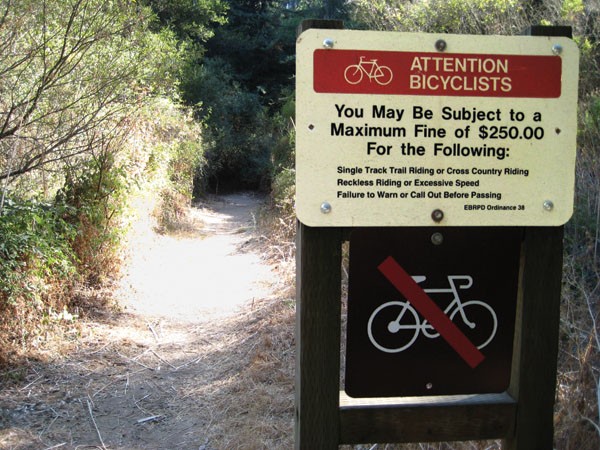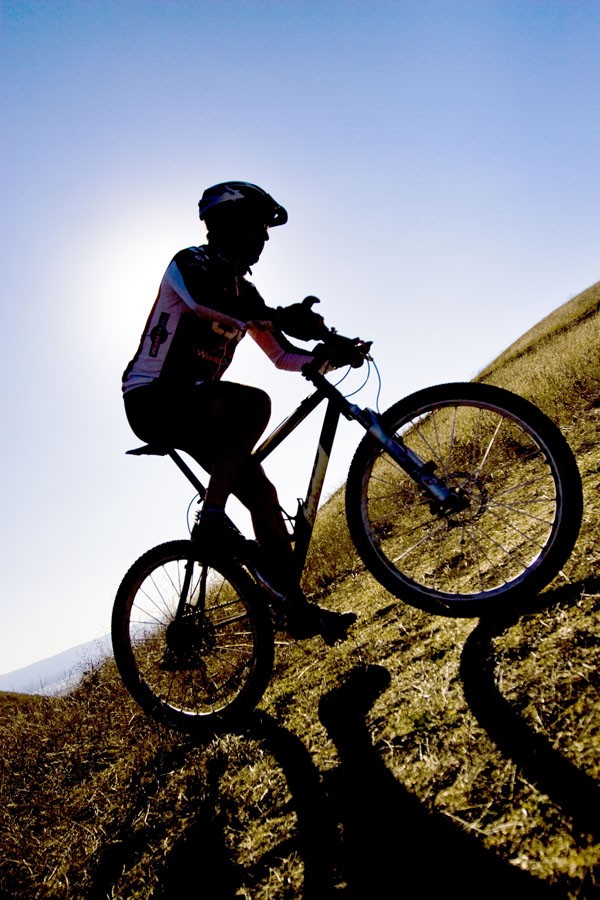There are few things Ted Stroll loves more than mountain biking. He began riding extensively in the East Bay hills after moving to Oakland in 1990, and at the age of 52 shows no signs of quitting. He has logged thousands of miles in parks like Tilden, Briones, Las Trampas, Pleasanton Ridge, and Redwood, and believes few people in the Bay Area have made more visits to district trails. Even after a recent move to San Jose, he’s adjusted his work schedule to allow for frequent afternoon rides. From afar, Stroll would appear to be one of the district’s biggest supporters. In reality, he’s one of its most vocal critics.
Earlier this year, Stroll and fellow riders J-C Poussin and John Grigsby came together under the name Better East Bay Parks for the sole purpose of opposing Measure WW, a $500 million bond measure aimed at helping the park district acquire new land. They argue that the district has failed to properly manage and provide access to its existing land, especially for mountain bikers, and is undeserving of more tax dollars until it cleans up its act.


Mountain bikers say the East Bay Regional Parks District has provided poor access to its land and allowed cattle grazing to crowd out other uses. Credits: Jared Gruenwald 

The parks district has poured tens of millions into land acquisition, but much less into opening those lands to new users. Credits: Jared Gruenwald 
Signs such as this one are a common sight in the East Bay Parks system. Credits: Nate Seltenrich 
Critics say mountain bikers pose a danger to other trail users. Credits: Jared Gruenwald 
Bikers complain about the lack of narrow single-track trails. Credits: Jared Gruenwald 
“We’re treated like second-class citizens,” said Stroll, who has served on the East Bay Regional Parks District’s volunteer bike patrol since 1993. Although bicyclists make up the second largest populace in the East Bay Regional Park District with 15 percent of all visits, bikes are banned from all but twenty of the parks’ approximately 150 miles of cherished narrow trails. Since mountain biking’s inception in the late 1970s on Marin’s Mount Tamalpais, riders have fought steadfastly for greater trail access. Critics have argued with equal fervor that bikes tear up trails and pose a safety hazard to other users including hikers and horseback riders. Twenty years of activism and advocacy in the East Bay has resulted in nominal success for the bikers, with just ten miles of existing narrow trails in regional parks opened to them and countless requests denied or ignored.
The conflict between mountain bikers and the powers that be crystallized at a July 29 meeting in Redwood Regional Park. Soon after Better East Bay Parks began flyering local bike shops with calls to oppose Measure WW, Assistant General Manager of Interagency Planning and Land Acquisition Bob Doyle announced a meeting to address the mountain biking community. Many biking advocates saw it as recognition that the district was worried about their potential opposition to the measure. This was, after all, the first time district staff had initiated a special meeting with the mountain biking community, and Doyle was the highest-ranking staff member who had ever offered to confer with them. About fifty bikers showed to see what would come of it, as did another eight decision-makers on park staff.
But Doyle, who helped author Measure WW, did most of the talking. He’d called everyone together not so much to lend an ear to the bikers’ gripes, but to help them learn how they could be more effective advocates within the district’s knotty bureaucratic and political landscape: namely, to rival the presence and power of the more established equestrian, hiking, and dog-walking contingents. He didn’t mince words, but offered to work with bikers on long-term solutions. “That’s how the system works. Advocacy is a long-term proposition, not short-term,” Doyle said later.
Although they felt vindicated to finally be acknowledged, the bikers weren’t pleased with the tenor of Doyle’s presentation. In the following days, popular forums at mountain biking web site MTBR.com buzzed with indignation. “Riders were insulted, disregarded, criticized, and their efforts over the years were ignored. They were accused of setting up this bad situation with the EBRBD. It was appalling,” one post read. Though they entered the meeting feeling they were finally making a stand, mountain bikers left with no new solutions and a bad taste in their mouths.
“Measure WW brings everything into focus,” said Stroll. “It’s our one chance to bring any kind of leverage against the parks district. There really is no downside to opposing Measure WW because the district has given us really nothing in the past and we have nothing to lose.” Along with Poussin and Grigsby, he feels that the only way for bikers to finally make their voice heard is to oppose the high-profile measure. “We better take this opportunity because it’s gonna be another twenty years before we get another one,” Grigsby added.
While it’s uncertain whether the mountain bikers are a strong enough group to sink Measure WW, or even if that’s the best method of achieving their goals, it’s clear that their opposition represents a growing voice within the park community. Regardless of what voters decide on November 4, this escalating struggle could have bold implications on business as usual in the East Bay Regional Parks District.
East Bay residents have long realized the importance of preserving public land. During the Great Depression, more than seven in ten voters agreed to tax themselves to create the East Bay Regional Parks District, which today is the country’s largest with 65 parks covering 98,000 acres.
Measure WW is the biggest bond measure proposed by the East Bay Regional Parks District in its seventy-four year history. It would extend Measure AA, which narrowly passed in 1988 and expires this year. Funded by a parcel tax against homeowners at the annual rate $10 per $100,000 of assessed value, AA was initially worth $225 million. Increased home values have more than doubled the amount of money the same tax would bring under WW.
“It’s the most important park measure that’s come before East Bay residents ever,” said Jim Townsend, Trails Development Program Manager for the district. More than 67 current and future parks are poised to benefit from the money, which is earmarked for a number of detailed projects that include establishing new parkland, building more trails, and linking wildlife corridors.. The district has already shown its ability to purchase property, adding 34,000 acres through 200 individual acquisitions over the past twenty years with money from Measure AA. It hopes this record of success will provide momentum for continued acquisitions through Measure WW.
Yet not everyone sees the district’s past in quite the same light. Complaints have come from bikers, hikers, and equestrians alike that many of the newer parks ostensibly remain ranchlands dominated by cattle grazing. The public can’t yet access about 15 percent of the district’s total acreage. And while the district boasts of adding 100 miles of regional trails using Measure AA funds, the vast majority has been preexisting ranch roads. In the same time period, the district has built only five miles of more scenic narrow- and single-track trails — something players on both sides of Measure WW agree is insufficient.
Mission Peak Regional Preserve in Fremont is, to the three men of Better East Bay Parks, a symbol of the East Bay Regional Parks District’s improper management of its parklands. They see it as an example of a park gone wrong, where ranching interests trump recreational and environmental concerns. Indeed, by late summer, most of the preserve’s 3,000 acres are carpeted in golden-brown grasses grazed within a few inches of the earth. Few other flora survive save the occasional old oak tree or stand of bull thistle. Most of the trails providing access to this environment are steep, dusty ranch roads spotted with cow pies.
Standing at Mission Peak, one can look west over the homes of more than a million people who could be out here enjoying the vast open space. Instead, only a handful have hiked uphill from a nearby trailhead for a view from the 2,500-foot peak and a quick jaunt back down. To the northeast is an expanse of rolling hills culminating in Mt. Diablo, a state park where grazing was outlawed in 1989. In stark contrast to many of its foothills, Diablo’s western facing slopes are swathed in dense oak savannahs. Stroll, Grigsby, and Poussin point to this as evidence that the East Bay Regional Parks District should follow suit.
“If they did, regional parks could be a paradise rather than a cattle ranch,” said Stroll. But the grazing program is unlikely to end anytime soon. The district contends it is necessary for both fire control and maintaining good relationships with local ranchers, who have become a primary source of new parkland. At the very least, Stroll would like to see mountain bikes allowed everywhere horses are. He has proposed a two-year trial program in which single-tracks are opened to mountain bikers on alternate days. Such a compromise could eventually serve as a wedge to open all the trails to everyone all the time, he hopes. However, history leaves Stroll doubting that even this modest solution will ever be adopted. “The reason I’m opposing WW is I have no confidence that will happen,” he said.
On the afternoon of September 20, the No on Measure WW campaign had an opportunity to air its concerns in a public forum. The Asian Pacific American Democratic Caucus of Alameda County was looking for someone to oppose Measure WW, and found an eager participant in John Grigsby. Opposite him, presenting the pro argument, was prominent East Bay environmentalist and vice-chair of the Yes on Measure WW campaign Norman LaForce, who’s running for an open spot on the East Bay Regional Parks District board this November.
In the three minutes he was given to present his case, Grigsby tried to lay out an argument with universal appeal: that more than 85 percent of the district’s stated 1,150 miles of trails are actually roads at least eight feet in width; that the money from Measure WW is more likely go toward maintaining cattle ranches as parks than preserving the natural environment; and that the district’s 2008 planned budget provides only $5.3 million for purchasing new lands out of $14.6 million in tax revenues from Measure AA.
LaForce, a longtime Sierra Club committee member and current chair of the Bay Chapter who has been active in advising and creating East Bay regional parks for 25 years, didn’t make much of Grigsby’s presentation. “The argument seemed to be really incoherent,” LaForce said later. He admits that he, too, has been critical of the district over the years, but doesn’t believe opposing Measure WW is the way to fix it. “If you have a problem with how the land’s managed, you should work with the parks district on it, and you certainly shouldn’t hold this bond measure hostage. … Frankly, I think they’re cutting off their noses to spite themselves.”
About a year before Measure AA passed in 1988, a proposal was batted around to ban mountain biking from East Bay parks altogether. It failed, but bikers took a hint: if they wanted to survive, they’d need to organize. The result was the Bicycle Trails Council of the East Bay, the second-oldest mountain bike advocacy group in the United States and one of the founding members of the International Mountain Bicycling Association. The council has served as the primary lobbying group for mountain bike access within the East Bay Regional Parks District for most of its history, but its successes can be counted on one hand: four trails, to be exact, over thirteen years of formal requests.
Although a recent internal poll of the club’s members revealed that about half were considering opposing Measure WW, doing so on the organizational level would be political suicide. The Trails Council doesn’t want to be seen as an enemy by the district, said President Brent Englund, and to come out against the measure and earn the district’s ire could erase the little ground it has gained. He also supports the measure for the simple fact that it will lead to more land acquisition in the East Bay. “We use those parks a ton. So we’re excited that they’re able to buy more land and acquire open space. We’re just upset about the access issue,” he said. “But without the land, there’s no access.”
Where Englund agrees with the men of Better East Bay Parks is that the district’s seven-member board of directors, which makes the final call on adding bike access to existing trails, harbors a bias against mountain bikers. President Ayn Weiskamp doesn’t deny the sentiment exists, both on the board and among board members’ constituencies. “We have a lot of people who hate bicycles,” she said. Most of them hold fast to conventional perceptions of narrow trails, meaning bikes don’t belong. The vast majority of the district’s narrow trails were built long before anyone thought of riding bikes on them. Sightlines and grades weren’t designed for use by higher-speed bikes. Plus, preexisting users feel like they’re losing something.
Traditionally, opponents of bike access have based their arguments on two points: erosion and safety. While the erosion argument has been discounted by numerous studies and all but dropped in recent years, trail safety remains a central concern. Many hikers and dog-walkers fear being blind-sighted by bikes coming too fast around a bend, while equestrians worry their horses could be spooked. Formal evidence of either within East Bay Regional Parks is minimal, but LaForce recounts one incident where three older board members surveying a trail for potential conversion to bike access had to jump out of the way of a speeding bike to avoid being hit.
“Mountain bikers are latecomers, and I think you had established groups who were hiking and horseback riding, and you have a few bikers who were speeding, and they saw them as invaders,” Weiskamp said. In response, she’s tried to explain that most bikers are mindful and respectful of other users. Sure enough, some of the opponents are coming around. “I think they’ve come to understand that a lot of these people are very dedicated athletes, and they’re all ages. They really want to enjoy the trail, it’s not just about the challenge.” Stroll, Grigsby, and Poussin couldn’t agree more, saying their experiences in other parks prove that incidents between riders and other users are rare and that the fear of bikes is vastly overstated.
The evolving attitude toward mountain bikers is evident in the language of Measure WW, which takes a step forward from earlier park rules that treated bicyclists as unequal users. All of the measure’s proposed project descriptions note that new trails will be designed “for all users” rather than for specific groups. “I think they can share the space,” Weiskamp said. “We all just have to learn to give a little. I feel pretty confident that we’re headed in the right direction.”
Yet building new trails poses another set of complications. Environmental regulations can stall projects for years, since much of the East Bay’s parkland is designated critical habitat for endangered species like the Alameda whipsnake, red-legged frog, and tiger salamander. From a permitting standpoint it’s much easier to use existing fire roads, and that’s precisely what has happened — to the chagrin of staff member Jim Townsend, who oversees regional trails. Building single-track trails “was something that we just didn’t do for a period of time,” he said. “It’s time to look inward at our parklands a little bit.” Using Measure WW funds and its equal-access language, Townsend’s goal is to build 100 miles of new single-track throughout the district over the next decade.
That won’t happen if Measure WW fails, and opposing the bond for the purpose of obtaining trail access is “really misguided,” said Townsend. “I don’t think they’re gonna scare the parks district into capitulating to their demands. It’s just gonna make things worse for them.” His suggestion is simply to keep plugging away. “They can be more successful in improving their riding experience in the parks by working with us. I know we’re not where they want us to be, but we’re getting closer.”
For a glimpse of what Stroll, Grigsby, and Poussin envision for East Bay regional parks, one needn’t travel far. A 500-acre plot nestled on the lower western slope of the Oakland hills and managed by the City of Oakland, Joaquin Miller Park is dwarfed by the East Bay Regional Parks District’s adjacent landholdings including Chabot and Redwood parks. But it does offer what many bikers consider the best narrow trails in the East Bay. The majority of the park’s approximately ten miles of single-track are open to all users, which, coupled with the park’s beautiful natural environment of lush ferns and dense redwoods, makes for a peak riding experience.
On the sort of temperate fall afternoon that endears people to the East Bay, the park’s diversity is on display in all its glory: joggers, dog-walkers, families, and mountain bikers of all stripes — men and women, young and old, solo and in groups, even a father teaching his young daughter to traverse obstacles on her small pink bike. Harmony is the rule of the road, and contrary to the expectations of shared-trail opponents, conflicts seem few and far between.
The magic ingredient is an oversight body called the Joaquin Miller Working Group. Comprised of representatives from each of the park’s various user groups, it allows different users to get to know each other rather than rely upon assumptions. Sue Piper, the Oakland city staff representative in the group, said that while there is some resistance to the liberal mountain bike access policy, bikers play an active role in the park — helping to build and maintain trails and install signage, for example — and everyone simply agrees to get along.
To Grigsby, this is no consolation in the face of the massive regional park district’s policies, but it does offer a glimmer of hope. He’s optimistic that bike access to beautiful places like this, especially for kids, will encourage appreciation of the outdoors and instill a desire to preserve it throughout their adult lives. “This is what mountain biking is supposed to be like,” he announces, grinning widely after a two-hour tour of Joaquin Miller’s best terrain. “This is why we love mountain biking.”





















